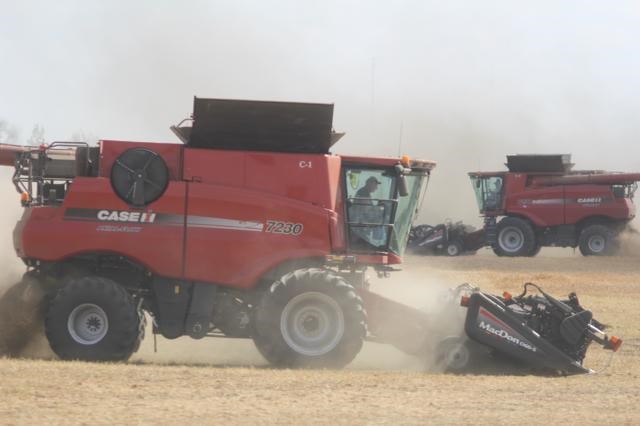Harvest operations are progressing in the southeast region, with about 37 per cent of this year’s crops in the bin, and another 30 per cent swathed or ready, according to Sask. Agriculture’s crop report. This is on par with the five-year average for this time of the year.
Provincially, harvest is about 26 per cent combined with 24 per cent of the crop swathed or ready for straight-cutting. Harvest in crop district 2A (Weyburn) is 48 per cent complete, and for 3ASE (Radville-Lake Alma) the harvest is 61 per cent complete.
For Creelman-area farmer Marcel Van Staveren, he estimates that he is about 60 per cent done this year’s harvest as of Friday, which is the furthest he has ever completed by Sept. 1 in the over 25 years he’s been farming.
“This is an indication of a dryer year and a thinner crop,” he said, noting his first crop off was his winter wheat, which yielded less than half of what he had in 2016.
As he and his two brothers have moved on to other crops, Van Staveren suspects this will be his worst result because of a lack of any significant rainfall. There were some good rains in mid-June, but it was too late to benefit this crop.
He said the lentil crop was actually similar to 2016’s yield, as it is a crop that does well in dry conditions. The canola crop was down by about 20 per cent from last year, and his spring wheat and durum crops are down by roughly 30 per cent from a year ago.
Van Staveren said his land began the season with a strong store of subsoil moisture, which enabled seeding in May to go well, and with the moisture in mid-June, there was enough moisture for the crops to keep growing — but the problem is that the subsoil moisture has now been depleted, and he is hoping for some rain this fall to help replenish the soil before winter. For the growing season as a whole, the farm received a total of about four inches of meaningful rain.
“Moving forward, that’s our biggest concern. If moisture doesn’t come, we might not plant winter wheat. We’ll worry about next year next year,” said Van Staveren.
While the canola crops are less than last year, he feels the results are reasonable given the amount of moisture they’ve had this year, and the yields weren’t down quite as much as for the cereal crops.
“We’re going to be spending less time doing tillage this fall. We managed to seed all of our acres this year, and every acre we seeded we’ve harvested crops from. Typically we lose about 10 per cent to flooding, and that didn’t happen this year,” said Van Staveren.
In addition to rain replenishing the moisture levels in the soil, he said some fall moisture would also help with weed control, which will in turn help improve the results for next year.
The last crops that they will be harvesting are soybeans, which normally wouldn’t be ready until around Sept. 20, but may be ready as early as Sept. 10 this year.
“They’re going to need 10 to 14 days to be ready for harvesting,” he said, estimating the soybeans may yield about half as they had last year.
Commodity prices have softened as they often do at harvest-time, said Van Staveren, but he is holding out hope that prices will recover by October or November. “Soybean prices are not too bad, but considering the yields, it’s not enough,” he said.
One plus that may help some farmers this year is exceptionally good quality grades. Last year had some very high yields in the area, but fusarium was a major problem that downgraded the prices of many wheat crops, and it hasn’t been an issue in this year’s crops, said Van Staveren.
“This year, most farmers should get a top grade for what they did grow,” he added.
For the southeast as a region, topsoil moisture on crop land is rated as 15 per cent adequate, 51 per cent short and 34 per cent very short. In crop districts 2A (Weyburn) and 3ASE (Radville-Lake Alma), 100 per cent of the hay and pasture land is short to very short of topsoil moisture, and in 3ASE, this includes the crop land as well.
Sask. Ag estimated crop yields for the various grains and oilseeds in the southeast region as follows: winter wheat and fall rye is 45 bushels per acre; hard red spring wheat is 39 bu/ac; durum is 31 bu/ac; oats are 66 bu/ac; barley is 61 bu/ac; flax is 18 bu/ac; canola is 27 bu/ac; soybeans are 20 bu/ac; peas are 32 bu/ac; canaryseed is 912 pounds per acre; mustard is 520 lbs/ac; lentils are 1,144 lbs/ac; and chickpeas are 850 lbs/ac.




